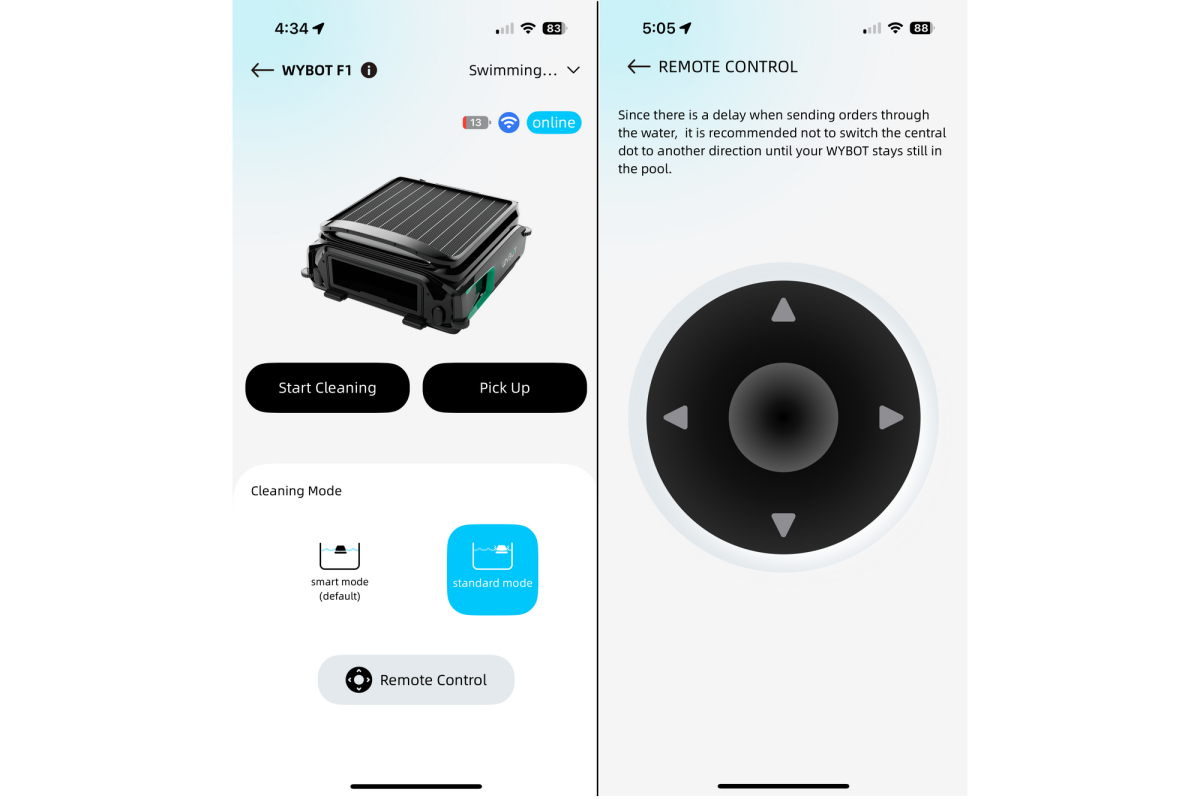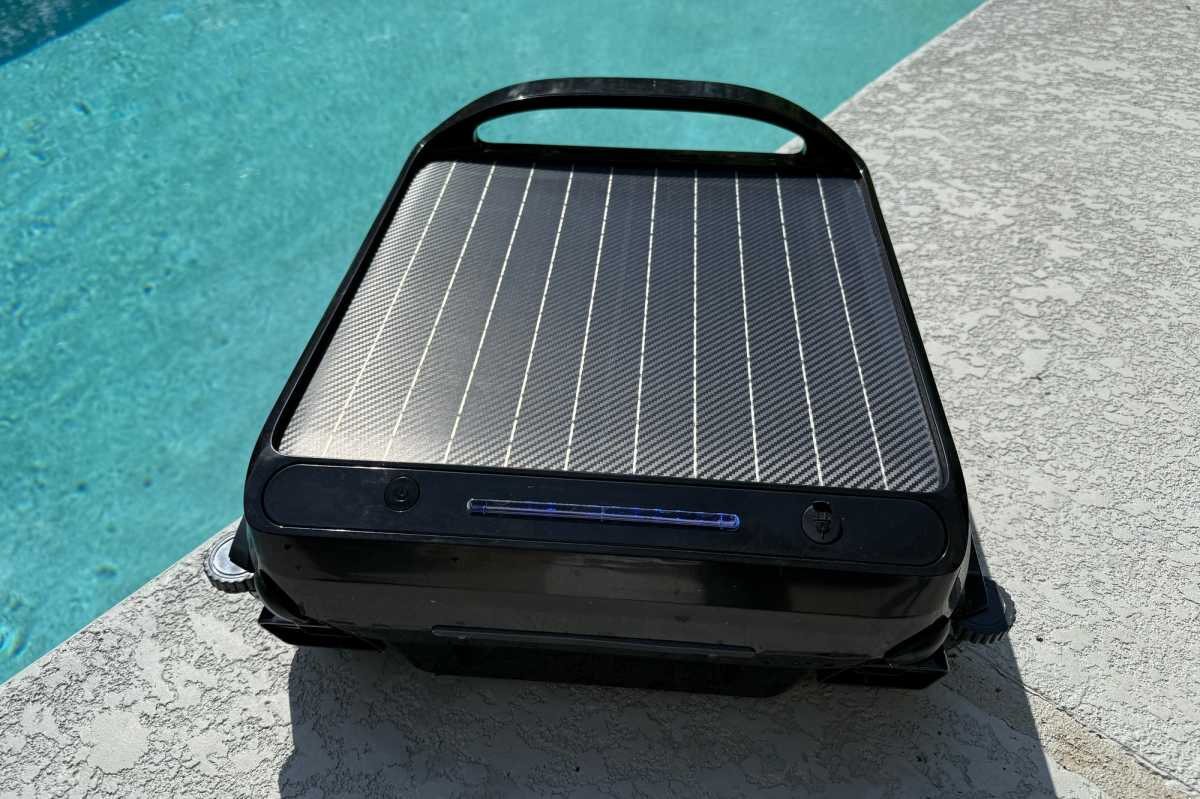Wybot F1 Pool Skimmer review: It’s loud, but it’s very effective
Table of Contents
Expert’s Rating
Pros
- The overall best skimmer at capturing debris in our tests
- Huge filter basket
- Remote control allows for manual steering when needed
Cons
- Extremely loud
- Blunt operation; runs into the wall Constantly
- Weak battery life
Our Verdict
Wybot’s solar skimmer does a surprisingly good job of grabbing leaves off the surface of the pool, but its loud operation and poor power management knock it down a peg.
Price When Reviewed
This value will show the geolocated pricing text for product undefined
Best Pricing Today
Price When Reviewed
$329.99
Best Prices Today: Wybot F1 Pool Skimmer
Solar-powered pool skimmers flit along the surface of your pool operating under the idea that if they can scoop up debris before it sinks, you won’t need to clean the bottom of the pool.
It sounds logical, but in practice, most pool skimmers don’t do the absolute best of jobs—there’s only so much surface area a skimmer can cover before leaves get waterlogged and sink to the depths. But robotic skimmers are better than nothing, especially if you don’t have a good in-wall skimmer.
The Wybot F1 Pool Skimmer was much more effective at capturing floating leaves than any skimmer I’ve used to date.
Specifications
Wybot’s F1 Solar Skimmer is perhaps the beefiest, burliest skimmer I’ve tested to date. The 14-pound beast is technically lighter than the 17-pound Beatbot iSkimmer Ultra I reviewed in January, but its appearance is more dominating, with a gaping maw in front as the gateway to a huge, 7-liter debris basket. (A small ridge inside the filter basket prevents debris from coming back out.)

The Wybot F1’s app has has two operating modes: standard and smart. You can also use a D-pad to manually navigate the bot around the surface of your pool.
Christopher Null/Foundry
As with all solar skimmers, a large solar panel makes up the entire top surface of the robot, the 33-watt panel feeding a 5200 mAh battery inside the chassis. An included plug-in charger can top up the battery if you don’t have enough sun to do the job.
Unlike most other skimmers I’ve tested, the F1 does not have visible paddles to propel and turn it in the pool. Rather, its propulsion system is hidden inside the chassis, secreted deep within two channels on either side of the device.
Two vents on either side of the robot are used when the Wybot F1 needs to back up, jetting water out so the robot can reverse. A long LED bar on the front of the device provides a quick look at status (running, charging, low battery, and so on), and owners of pools with very shallow areas can pop out four anti-stranding bars on the bottom of the device to prevent the robot from reaching certain areas where there’s not enough water to work in.
Performance
When starting up the robot, what you’ll notice immediately is how loud it is. The impellers inside the robot sound like the props on a small airplane, whirring and sputtering and blubbering to a degree I’ve not encountered in any pool-cleaning device. The robot putters around the pool (at a healthy clip) scooping up debris, but it almost sounds like an actual boat. More than one visitor spotting it at work in the pool remarked about its noise production.
The Wybot F1 has two operating modes, which you can select through the Wybot app: standard mode and smart mode; with the latter—ironically—being its default mode. Standard mode runs the robot continuously until its battery dies, then waits until it is fully charged to start running again.

The Wybot F1 has a very large filter basket that captured a lot of leaves in our tests.
Christopher Null/Foundry
Smart mode adjusts the robot’s runtime based on available sunshine to keep it running on and off throughout the day, ostensibly maintaining enough charge on the battery to avoid long periods of downtime. The app also includes a remote control that can—rather crudely—direct the robot around the pool to areas of particular trouble.
The skimmer is not the most intelligent I’ve tested, as it is prone to winding itself up to maximum speed then run headlong straight into the wall. Hand it to the F1 though, as it doesn’t like to give up. After a few seconds of rest, it will often try to push forward directly into the wall once again before, eventually, it realizes it’s not making progress. At last, one of the backup vents will engage and the robot will make a turn, then jet off to greener, dirtier pastures.
Somehow this all works pretty well. Its fast speed and sheer tenacity let the F1 cover a lot of ground quickly, but it’s the enormous opening for the filter basket that seems to be the secret sauce. Other solar skimmer designs often push debris to either side as the ploddingly slow robot creeps closer, causing that debris to be entirely missed, the the F1’s wide mouth allows for no escape.
The Wybot F1 was much more effective at capturing floating leaves in my testing than any other skimmer I’ve used to date, collecting about 85 percent of the leaves in my test samples while the remainder sunk to the bottom. (Only a couple remained on the surface after about four hours of running time.)
Although it can be tough to dislodge its filter basket, cleanup is reasonably easy, as the basket splits into two parts, allowing for an easier washout. That said, it would be handy if the rear of the basket also opened to allow debris to pass through to the other side.
The inevitable caveats

A large solar panel forms the top surface of the Wybot F1 Skimmer; unfortunately, it didn’t seem capable of keeping the robot’s battery charged for all-day operation.
Christopher Null/Foundry
Unfortunately, the Wybot F1 isn’t perfect. That extra speed equates to a short battery life, and I was never able to get the robot to run for a full day without its battery dying, even under the summer sun of Texas. Its battery is also slow to charge. Even on relatively sunny days, I often found the robot didn’t run at all during the day in standard mode because it had never fully recharged.
Wybot’s app is very simple, primarily used to select between the two operating modes and to activate the remote control; but the Bluetooth and 2.4GHz Wi-Fi-connected system also provides one critical metric: remaining battery life.
The problem is that I could never get this battery indication to update without force-quitting the app and restarting it. No matter what I did, the battery indicator would remain stuck on whatever level it was at the last time I checked it.
This review is part of TechHive’s in-depth coverage of the best robotic pool cleaners.
This can be a real pain when you check the app and see the robot has 98 percent battery life remaining, only to restart the app to find that the true remaining battery life is just 13 percent.
Should you buy the Wybot F1 Pool Skimmer?
At $330 (street price), the Wybot F1 is vastly cheaper than the $1,499 Beatbot iSkim Ultra I reviewed in January, and it’s competitive with the $340 Smonet SR5 I evaluated in November 2024.
If you don’t mind the din it creates while it’s puttering around the pool—heck, you might even find the noise endearing—it’s arguably the skimmer to beat.





